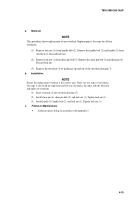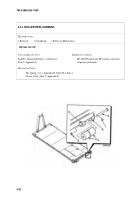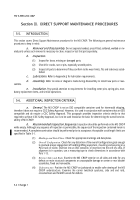TM-9-3990-260-14-P - Page 111 of 306
TM 9-3990-260-14&P
Change 1
4-17
(1)
Position spacer (17) on pin support plate (12).
(2)
Secure spacer (17) in place with screw (16), flat washer (15), and new lock nut (14).
(3)
Attach lifting device to end structure assembly bail bar (1).
(4)
Check the end structure assembly pin support plates (12 and 13) to ensure that the holes
where the front and rear pins (3 and 10) will be inserted and the front and rear pins (3 and
10) are clean and completely free of dirt, sand, or other contamination.
(5)
Apply a light film of grease (GAA) to rear pins (10).
(6)
Using lifting device, position end structure assembly and insert two rear pins (10) through
the pin support plates (12 and 13). Install lock washers (9) and castle nuts (8) finger tight.
(7)
Apply a light film of grease (GAA) to front pins (3).
(8)
Using assistant and lifting device, position end structure assembly and insert two front pins
(3) through the pin support plates (12 and 13). Install lock washers (9) and castle nuts (8)
finger tight.
(9)
While holding front pins (3) with pin tightening tool (4), tighten castle nut (8) clockwise
using the socket wrench (6) with 2-1/4 inch socket (5). Ensure the end structure assembly
is centered between support plates (12 and 13) by alternately tightening each castle nut (8).
Ensure the split in each lock washer is compressed and the nuts are firmly tightened using
full arm strength only. Do not over tighten by standing on the socket wrench, using your
feet to push against the socket wrench, or using other leverage gaining means such as a
“cheater bar or pipe.” Do not use pin tightening rod to turn front pins. Use the socket and
wrench to tighten castle nuts.
(10) While holding rear pins (10) with pin tightening tool (4), tighten castle nut (8) clockwise
using the socket wrench (6) and 2-1/4 inch socket (5). Ensure the split in each lock washer
is compressed and the nuts are firmly tightened using full arm strength only. Do not over
tighten by standing on the socket wrench, using your feet to push against the socket
wrench, or using other leverage gaining means such as a “cheater bar or pipe.” Do not use
pin tightening rod to turn rear pins. Use the socket and wrench to tighten castle nuts.
(11)
Secure castle nuts on both rear pins using new cotter pins (11).
NOTE
A tether is no longer used to secure hitch pin clips on later model CROPs.
(12) Secure castle nuts on both front pins using hitch pin clips (2).
(13) Disconnect and remove lifting device.
(14) Return the pin tightening rod (4), 2-1/4 inch socket (5), socket wrench (6), and hammer (7)
to the CROP stowage boxes or into the front storage areas on the M3 CROP (S/N SC09001
and up).
c.
Follow-on Maintenance.
None.
Back to Top




















